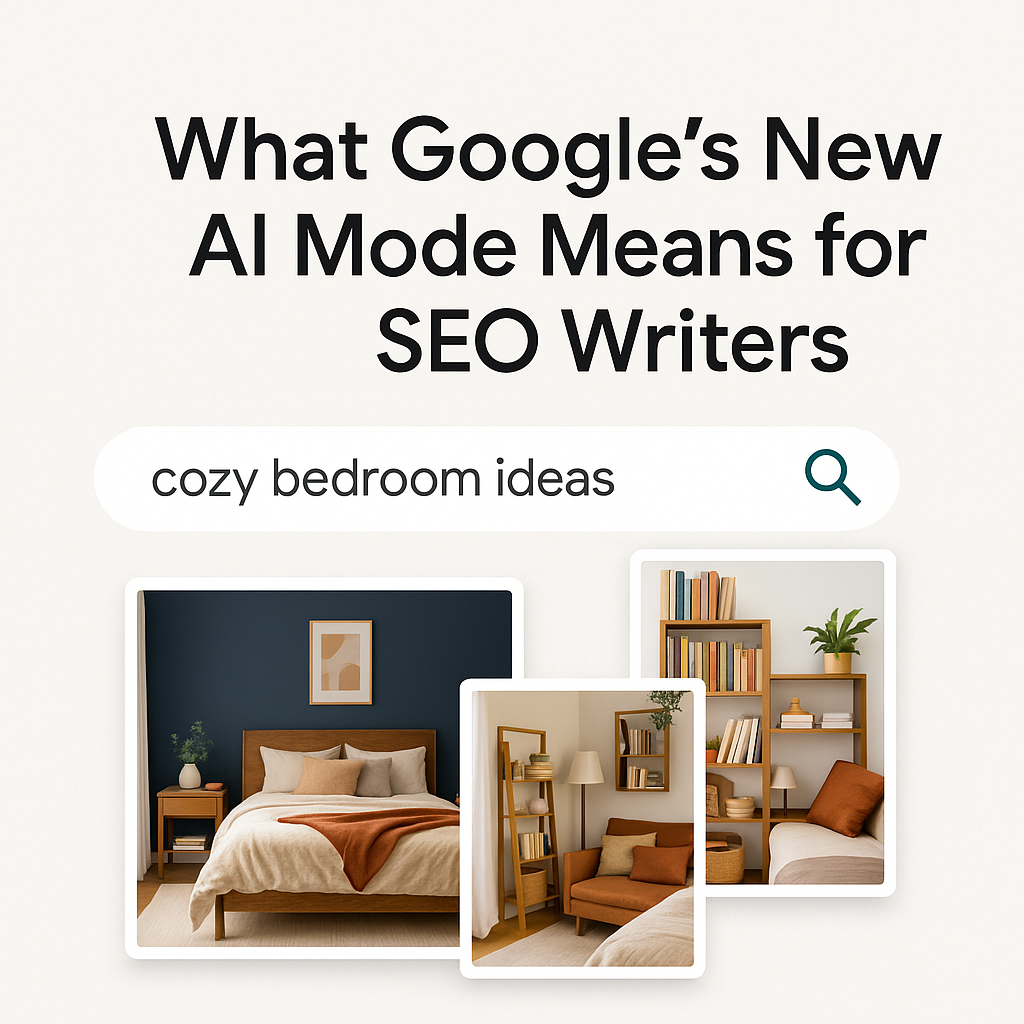What Google’s New AI Mode Means for SEO Content Writers

Short Answer: Google announced today (September 30, 2025) a new AI Mode in Search that lets people explore with pictures, natural language, and product descriptions. For SEO content writers, this means one thing: you can’t just write for keywords anymore. You need to write for how people actually talk, describe, and even see the world.
Introduction
Google just shook up search again. Earlier today, they unveiled a new AI Mode update that changes the way people interact with Search (official announcement here). With this rollout, users can describe what they want or even snap a picture and instantly get a mix of visuals, shopping results, and deeper context.
Picture this: someone takes a quick photo of their cluttered living room and asks, “show me cozy bookshelf ideas that fit small spaces” and Google responds with design images, product links, and even DIY tutorials.
Exciting for users. But for SEO writers like us? It’s a reality check.
This isn’t just another tweak to the algorithm. It’s proof that search is moving away from plain keywords and closer to how humans naturally describe things. If we want our content to show up, we have to adapt.
What Changed in Search
-
Conversational visual search: Search with words and images
-
Visual “fan-out”: Google looks inside images and runs side-queries on the details it finds
-
Shop by description: Forget clunky filters; describe what you want and Google finds it
-
AI Mode launch: Rolling out in the U.S. first, powered by Gemini 2.5
What It Means for Writers
1. Write like people talk
Forget stiff product blurbs. If a customer would say “tea that helps me sleep without tasting bitter”, your copy should echo that vibe. Natural phrases plus entity terms equal discoverability.
2. Images are now text too
Google is literally reading pictures. Alt text, captions, and metadata can’t be afterthoughts anymore. If your honey jar photo shows comb, pollen, and raw crystals, spell that out.
3. Conversations beat keywords
People aren’t searching “best herbal tea” anymore. They’re asking questions, rambling through descriptions, and expecting Google to get it. Your H2s and FAQs should mirror that.
4. Cover every attribute
The more you describe — flavors, textures, sizes, emotions — the more hooks Google has to match your content. It’s entity coverage, not keyword stuffing.
5. Authentic visuals win
Stock photos won’t cut it when AI is dissecting image details. Real product shots, lifestyle pics, and visual context matter just as much as the words on the page.
Why This Matters
Search isn’t just text anymore. It’s words, visuals, and human descriptions all colliding. As content writers, we’re not just keyword jockeys. We’re storytellers who need to think multimodally.
This update rewards content that feels alive: conversational, descriptive, and grounded in real-world detail. If you’re writing the same stiff SEO blurbs you were in 2020, you’re invisible now.
FAQ
Do I need to rewrite everything?
Nope. Start with your most important content — your high-traffic pages and product listings — and layer in natural descriptions.
Is alt text really a ranking factor now?
More than ever. Alt text is now a direct signal in AI Mode’s visual discovery.
How do I know what descriptors users will type?
Listen to how people actually talk. Use “People Also Ask,” listen to customer calls, and brainstorm in tools like ChatGPT.
Conclusion: Writers Are Becoming Visual Optimizers
Today’s announcement proves it: SEO writing isn’t just about words anymore. It’s about capturing how people describe things, how they ask questions, and how they see the world.
Your job now? Write like you’re in conversation with your reader. Describe the product the way they would. Pair your words with strong, authentic visuals. That’s how you future-proof your content in the age of AI Mode.

0 Comments Add a Comment?